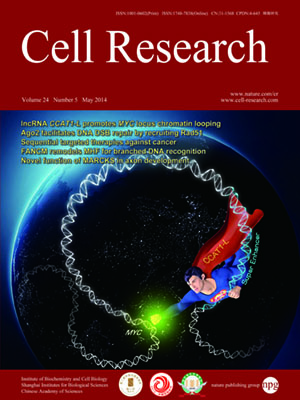
Volume 24, No 5, May 2014
ISSN: 1001-0602
EISSN: 1748-7838 2018
impact factor 17.848*
(Clarivate Analytics, 2019)
Volume 24 Issue 5, May 2014: 560-575
ORIGINAL ARTICLES
The histone-fold complex MHF is remodeled by FANCM to recognize branched DNA and protect genome stability
David Fox 3rd1,*, Zhijiang Yan1,*, Chen Ling1, Ye Zhao2, Duck-Yeon Lee3, Tatsuo Fukagawa4, Wei Yang2 and Weidong Wang1
1Laboratory of Genetics, National Institute on Aging, National Institutes of Health, Baltimore, MD 21224, USA
2Laboratory of Molecular Biology, National Institute of Diabetes and Digestive and Kidney Diseases, National Institute of Health, Bethesda, MD 20892, USA
3Biochemistry Core Facility, National Heart, Lung and Blood Institute, National Institutes of Health, Bethesda, MD 20892, USA
4Department of Molecular Genetics, National Institute of Genetics and the Graduate University for Advanced Studies, Mishima 411-8540, Japan
Correspondence: Weidong Wang, Tel: +1 410-558-8334; Fax: +1 410-558-8331(wangw@grc.nia.nih.gov)
Histone-fold proteins typically assemble in multiprotein complexes to bind duplex DNA. However, one histone-fold complex, MHF, associates with Fanconi anemia (FA) protein FANCM to form a branched DNA remodeling complex that senses and repairs stalled replication forks and activates FA DNA damage response network. How the FANCM-MHF complex recognizes branched DNA is unclear. Here, we solved the crystal structure of MHF and its complex with the MHF-interaction domain (referred to as MID) of FANCM, and performed structure-guided mutagenesis. We found that the MID-MHF complex consists of one histone H3-H4-like MHF heterotetramer wrapped by a single polypeptide of MID. We identified a zinc atom-liganding structure at the central interface between MID and MHF that is critical for stabilization of the complex. Notably, the DNA-binding surface of MHF was altered by MID in both electrostatic charges and allosteric conformation. This leads to a switch in the DNA-binding preference — from duplex DNA by MHF alone, to branched DNA by the MID-MHF complex. Mutations that disrupt either the composite DNA-binding surface or the protein-protein interface of the MID-MHF complex impaired activation of the FA network and genome stability. Our data provide the structural basis of how FANCM and MHF work together to recognize branched DNA, and suggest a novel mechanism by which histone-fold complexes can be remodeled by their partners to bind special DNA structures generated during DNA metabolism.
10.1038/cr.2014.42
FULL TEXT | PDF
Browse 2215


